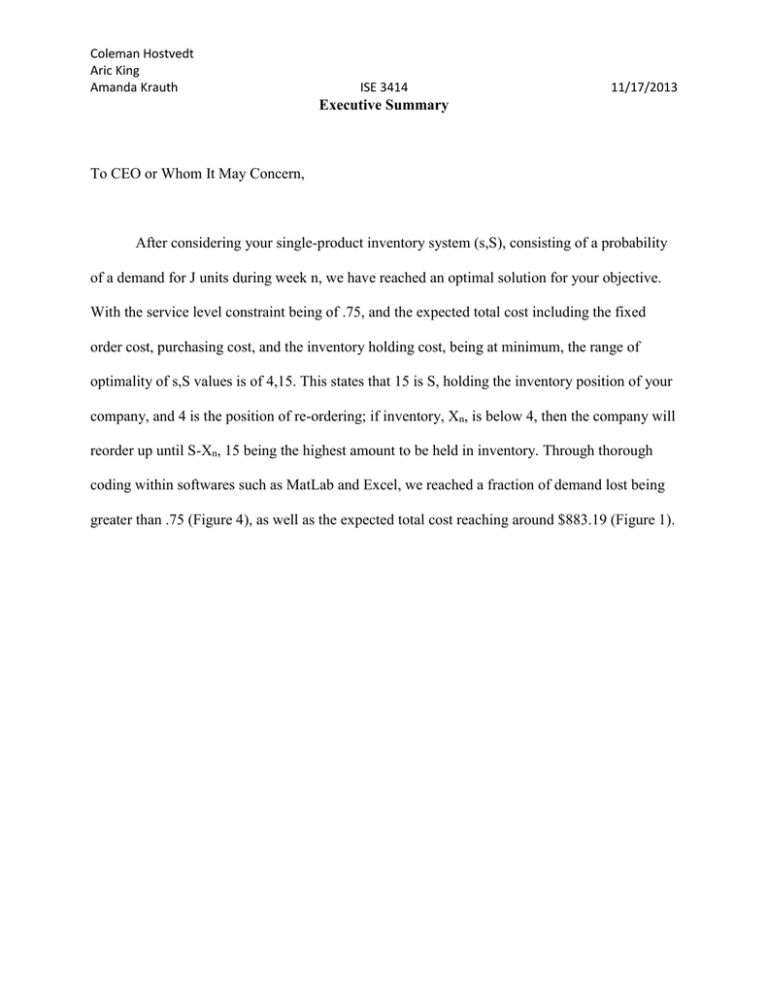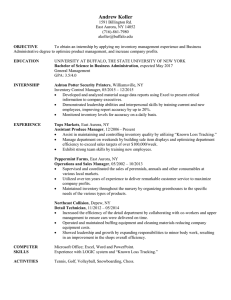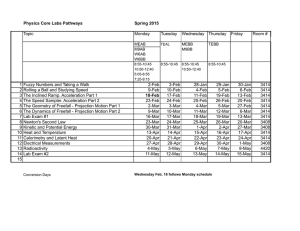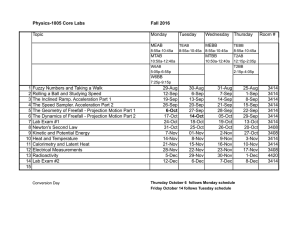Project 2
advertisement

Coleman Hostvedt
Aric King
Amanda Krauth
ISE 3414
11/17/2013
Executive Summary
To CEO or Whom It May Concern,
After considering your single-product inventory system (s,S), consisting of a probability
of a demand for J units during week n, we have reached an optimal solution for your objective.
With the service level constraint being of .75, and the expected total cost including the fixed
order cost, purchasing cost, and the inventory holding cost, being at minimum, the range of
optimality of s,S values is of 4,15. This states that 15 is S, holding the inventory position of your
company, and 4 is the position of re-ordering; if inventory, Xn, is below 4, then the company will
reorder up until S-Xn, 15 being the highest amount to be held in inventory. Through thorough
coding within softwares such as MatLab and Excel, we reached a fraction of demand lost being
greater than .75 (Figure 4), as well as the expected total cost reaching around $883.19 (Figure 1).
Coleman Hostvedt
Aric King
Amanda Krauth
ISE 3414
11/17/2013
Problem Definition:
Our company was asked to analyze a single- product inventory system through MarkovChain modeling to minimize the expected total cost. The total cost includes: fixed order cost,
purchasing cost, and inventory holding cost; we can change the total cost by changing the reorder
threshold (s) and the maximum inventory limit (S). We also must stay within the constraint of
Beta, which is the fraction of the demand lost. Through this analysis we were trying to
determine the long run fractions of demand lost, weeks in which an order is placed, and weeks in
which a shortage occurs; the long run amounts of demand lost, orders placed per week, and the
average total cost; and finally we wanted to determine the optimal values for s and S.
We used our knowledge of Markov chains, Matlab, and Excel to conduct this analysis.
Specifically, we used Matlab to create the TPM including all the probabilities, then used these
values in Excel to determine the expected total cost for each iteration where we changed the s
and S values.
Coleman Hostvedt
Aric King
Amanda Krauth
ISE 3414
11/17/2013
Analysis
Phase I:
We first discovered that the problem was a Discrete Markov Chain and created a TPM.
Based on our intuition, we created Formulas for each long run value that involved the limiting
distribution, the demand probabilities, and the cost values that were provided. The formula for
expected total cost is as follows:
𝑠−1
𝑠−1
∞
∞
+
∑𝑠−1
𝑖=0 Πi[800+40(s-i)]+ 5[∑𝑖=0 Πi x ∑𝑗=0 P(D=j)(s - j) + ∑𝑖=𝑠 Πi x ∑𝑖=0 𝑃 (D=j)(i - j) ]
Phase II:
We started by drawing a transition diagram showing that {Xn, n ≥ 0} is one class
(irreducible), aperiodic, and positive recurrent. By definition, this means the class is ergodic.
We then used our Matlab code to create the TPM and the TPM raised to the 100th power and
determine the limiting distributions (see Figure 2 and Figure 3). We plugged these values into
our Excel document to determine the expected cost and β value for s = 4 and S = 15 (stated in
conclusions). Refer to figure 1 in the appendix.
Phase 3:
To reach our conclusions, we used excel to find our Beta and expected total cost. We
broke the expected total cost equation into three parts, A, B,C, found in our excel data sheet. For
beta, we broke it down step by step to multiply things out thoroughly without making mistakes.
Excel seemed the most reasonable software to use for such a task of inventory due to the
minimal amount of errors to overcome.
Coleman Hostvedt
Aric King
Amanda Krauth
ISE 3414
11/17/2013
Conclusions:
Long run fraction of weeks in which an order is placed is represented by
∑𝑠−1
𝑖=0 Πi
Long run fraction of weeks in which a shortage occurs is represented by
𝑠−1
∑𝑠−1
𝑖=0 Πi P(D > s) + ∑𝑖=0 Πi P(D > i)
Long run average amount of demand lost per week is represented by
𝑆
∞
∞
∑𝑠−1
𝑖=0 Πi 𝑥 ∑𝑗=𝑠+1(j − s)P(D = j) + ∑𝑖=0 Πi 𝑥 ∑𝑗=𝑖+1(j − i)P(D = j)
Long run fraction of demand lost per week is represented by
𝑗−𝑠
∞
∑𝑠−1
𝑖=0 Πi 𝑥 ∑𝑗=𝑠+1 (
𝑗
) P(D = j) + ∑𝑆𝑖=𝑠 Πi 𝑥 ∑∞
𝑗=𝑖+1 (
𝑗−𝑖
𝑗
) P(D = j)
Long run amount of order placed per week is represented by
∑𝑠−1
𝑖=0 Πi(s-i)
Long run average total cost is represented by
𝑠−1
𝑠−1
∞
∞
+
∑𝑠−1
𝑖=0 Πi[800+40(s-i)]+ 5[∑𝑖=0 Πi x ∑𝑗=0 P(D=j)(s - j) + ∑𝑖=𝑠 Πi x ∑𝑖=0 𝑃 (D=j)(i - j) ]
{Xn, n ≥ 0} is ergodic.
The expected total cost for (4,15) is $883.19 with a lost demand of12.587%.
Coleman Hostvedt
Aric King
Amanda Krauth
Appendix:
Figure 1
Figure 2
ISE 3414
11/17/2013
Coleman Hostvedt
Aric King
Amanda Krauth
Figure 3
Figure 4
ISE 3414
11/17/2013




